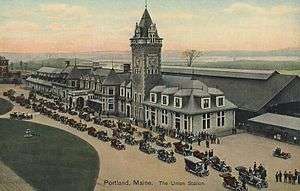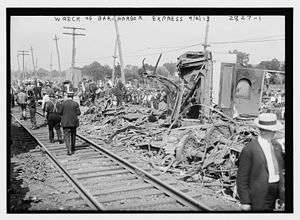Bar Harbor Express

The Bar Harbor Express was a seasonal passenger train which served the resort areas around Bar Harbor, Maine, in the United States. It was a joint venture of the New York, New Haven and Hartford Railroad, the Maine Central Railroad and the Boston and Maine Railroad (B&M).
History
The Bar Harbor Express began in 1902 with its southern terminus in New York. Trains ran north to Springfield, Massachusetts, over the New Haven, where they were handed off to the Boston and Albany Railroad (B&A), which carried them to Worcester. From Worcester the B&M hauled them to Union Station in Portland, Maine. From Portland the Maine Central hauled the cars to their final destinations in the northeast. The B&A withdrew early on, however, so the trains followed a purely New Haven routing from New York to Worcester. The lack of a direct connection between Boston's North Station and South Station precluded a Boston section.[1]
The completion of the Hell Gate Bridge in 1917 allowed direct rail service from New England through New York to points south, so the New Haven added Washington, D.C., and Philadelphia, Pennsylvania, sections to the Bar Harbor Express which were hauled by the Pennsylvania Railroad. Destinations north of Portland included Ellsworth, Mount Desert Ferry and Rockland.[2]
In 1952 a typical consist of the Bar Harbor Express included sleepers from Washington, Philadelphia and New York to Ellsworth; Philadelphia to Portland; Philadelphia and New York to Rockland; and New York to Plymouth, New Hampshire. The latter was a Friday-only connection with the B&M in Lowell, Massachusetts.[3]
The Bar Harbor Express was hurt by the post-World War II decline in passenger rail traffic which afflicted all passenger services, compounded by a 1947 fire in Bar Harbor. In 1957 the Maine Central truncated the run to Bangor, and ended the train altogether on Labor Day, 1960.[4][5]
1913 wreck

On the morning of September 2, 1913, north of New Haven, Connecticut, travelling at 40 miles per hour in heavy fog, the White Mountain Express crashed through two cars of the Bar Harbor Express and overturned a third coach, killing 21 and injuring 50.[6]
Notes
- ↑ Maiken (1989), 18-19.
- ↑ Maiken (1989), 18-19.
- ↑ Maiken (1989), 349.
- ↑ Maiken (1989), 19.
- ↑ Schwieterman (2001), 107.
- ↑ "Sleeping Homecomers Victims of Rear-end Collision". New York Times. September 3, 1913. Retrieved 2010-01-09.
With twenty-one persons dead and over two score injured, many of them mortally, the first day of office of Howard Elliott, who succeeded Charles S. Mellen as President of the New York, New Haven Hartford, was ushered in by one of the most disastrous wrecks even in the history of that disastrous road, surpassing in horror any that had darkened the administration of his predecessor.
References
- Maiken, Peter (1989). Night Trains: The Pullman System in the Golden Years of American Rail Travel. Baltimore: Johns Hopkins University Press. ISBN 0-8018-4503-3.
- Schwieterman, Joseph P. (2001). When the Railroad Leaves Town: American Communities in the Age of Rail Line Abandonment, Eastern United States. Kirksville, MO: Truman State University Press. ISBN 0-943549-97-3. OCLC 702179808.
External links
- Bar Harbor Express at Flickr
- Bar Harbor Express at GenDisasters